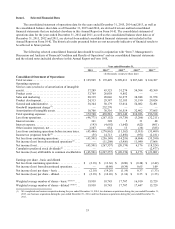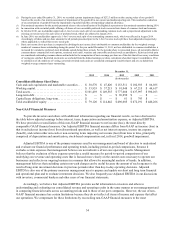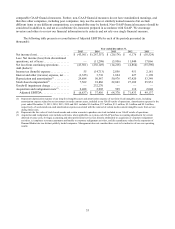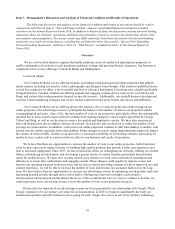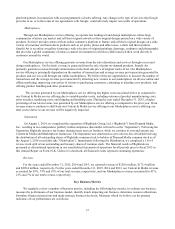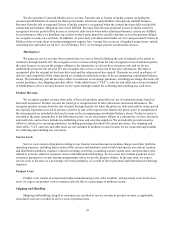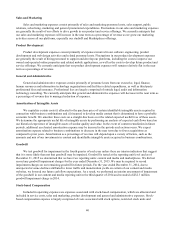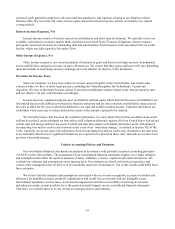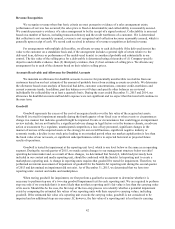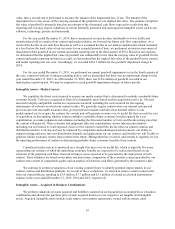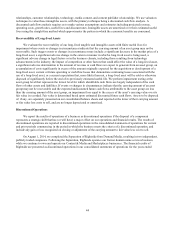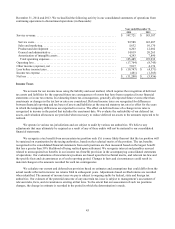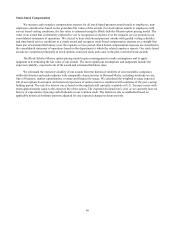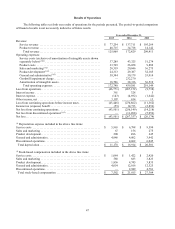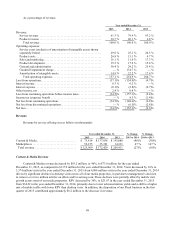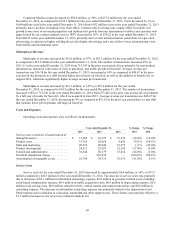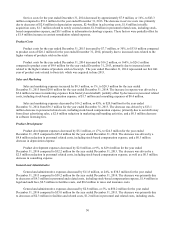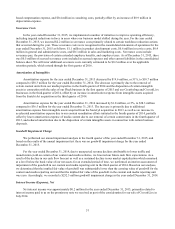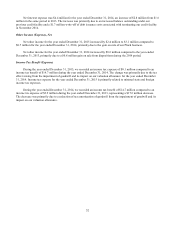Enom 2015 Annual Report Download - page 44
Download and view the complete annual report
Please find page 44 of the 2015 Enom annual report below. You can navigate through the pages in the report by either clicking on the pages listed below, or by using the keyword search tool below to find specific information within the annual report.42
Revenue Recognition
We recognize revenue when four basic criteria are met: persuasive evidence of a sales arrangement exists;
performance of services has occurred; the sales price is fixed or determinable; and collectability is reasonably assured.
We consider persuasive evidence of a sales arrangement to be the receipt of a signed contract. Collectability is assessed
based on a number of factors, including transaction history and the credit worthiness of a customer. If it is determined
that collection is not reasonably assured, revenue is not recognized until collection becomes reasonably assured, which is
generally upon receipt of cash. We record cash received in advance of revenue recognition as deferred revenue.
For arrangements with multiple deliverables, we allocate revenue to each deliverable if the delivered item(s) has
value to the customer on a standalone basis and, if the arrangement includes a general right of return relative to the
delivered item, delivery or performance of the undelivered item(s) is considered probable and substantially in our
control. The fair value of the selling price for a deliverable is determined using a hierarchy of (1) Company-specific
objective and reliable evidence, then (2) third-party evidence, then (3) best estimate of selling price. We allocate any
arrangement fee to each of the elements based on their relative selling prices.
Accounts Receivable and Allowance for Doubtful Accounts
We maintain an allowance for doubtful accounts to reserve for potentially uncollectible receivables from our
customers based on our best estimate of the amount of probable losses from existing accounts receivable. We determine
the allowance based on an analysis of historical bad debts, customer concentrations, customer credit-worthiness and
current economic trends. In addition, past due balances over 60 days and specific other balances are reviewed
individually for collectability on at least a quarterly basis. During the years ended December 31, 2015 and 2014, our
allowance for doubtful accounts and bad debt expense were not significant and we expect that this trend will continue in
the near term.
Goodwill
Goodwill represents the excess of the cost of an acquired entity over the fair value of the acquired net assets.
Goodwill is tested for impairment annually during the fourth quarter of our fiscal year or when events or circumstances
change in a manner that indicates goodwill might be impaired. Events or circumstances that could trigger an impairment
review include, but are not limited to, a significant adverse change in legal factors or in the business climate, an adverse
action or assessment by a regulator, unanticipated competition, a loss of key personnel, significant changes in the
manner of our use of the acquired assets or the strategy for our overall business, significant negative industry or
economic trends, a decline in our stock price leading to an extended period when our market capitalization is less than
the book value of our net assets, or significant underperformance relative to expected historical or projected future
results of operations.
Goodwill is tested for impairment at the reporting unit level, which is one level below or the same as an operating
segment. During the second quarter of 2015, we made certain changes to our management structure below our chief
operating decision maker and, as a result of these changes, we determined that Society6, which had previously been
included in our content and media reporting unit, should be combined with the Saatchi Art reporting unit to create a
marketplaces reporting unit. A change in reporting units requires that goodwill be tested for impairment. Therefore, we
performed an interim assessment of impairment of goodwill for the Saatchi Art reporting unit during the second quarter
of 2015 and determined an impairment did not exist. As of December 31, 2015, we determined that we have two
reporting units: content and media and marketplaces.
When testing goodwill for impairment, we first perform a qualitative assessment to determine whether it is
necessary to perform step one of a two-step goodwill impairment test for each reporting unit. We are required to perform
step one only if we conclude that it is more likely than not that a reporting unit’s fair value is less than the carrying value
of its assets. Should this be the case, the first step of the two-step process is to identify whether a potential impairment
exists by comparing the estimated fair values of our reporting units with their respective carrying values, including
goodwill. If the estimated fair value of a reporting unit exceeds the carrying value, goodwill is not considered to be
impaired and no additional steps are necessary. If, however, the fair value of a reporting unit is less than its carrying



